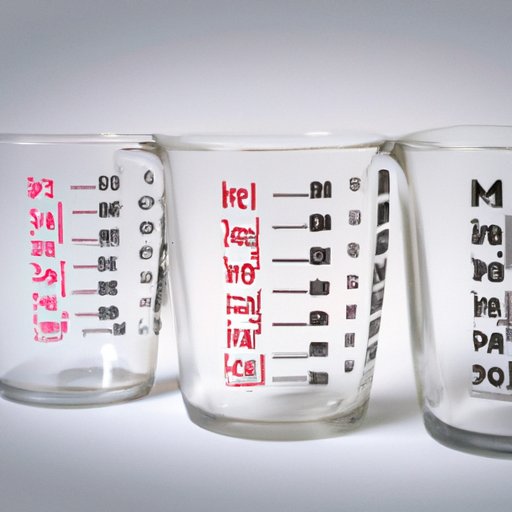Introduction
Whether you’re a cook, a baker, or just someone who needs to measure liquid, one question that often arises is how many cups are in a liter. Cups and liters are two different units of measurement that can sometimes be confusing to work with. In this article, we will provide a comprehensive guide to understanding cups, liters, and how to convert between the two.
Converting Cups to Liters: A Quick Guide
The simplest way to convert cups to liters is by using a formula. One liter is equal to 4.2268 cups, or approximately 4 1/4 cups. To convert a certain number of cups to liters, simply divide that number by 4.2268.
For example, let’s say you want to convert 6 cups to liters:
6 cups ÷ 4.2268 = 1.419 liters
Therefore, 6 cups is approximately equal to 1.419 liters.
Knowing Your Measurements: Understanding Cups and Liters
Cups and liters are both units of volume measurement, but they are used in different contexts. Cups are commonly used in the United States for measuring liquids and dry ingredients for cooking and baking, while liters are used in the metric system for measuring larger quantities of liquid, such as in scientific experiments or in other countries.
It’s important to know which measurement to use depending on the recipe or the context in which you are measuring. For example, if you are using a recipe from a European cookbook, the recipe may call for ingredients to be measured in liters, while if you are using a recipe from an American cookbook, the recipe may call for ingredients to be measured in cups.
Here’s a conversion chart for easy reference:
| Cups | Liters |
|---|---|
| 1/4 cup | 0.059 liters |
| 1/3 cup | 0.079 liters |
| 1/2 cup | 0.118 liters |
| 1 cup | 0.236 liters |
| 2 cups | 0.473 liters |
| 4 cups | 0.946 liters |
| 8 cups | 1.892 liters |
Baking with Accuracy: Understanding the Science of Measuring Cups and Liters
Accurate measurements are crucial when baking, as even a small difference in the amount of ingredients used can significantly affect the final outcome of the recipe. When measuring ingredients using cups or liters, it’s important to follow proper measuring techniques to ensure accuracy.
Some tips for measuring cups and liters include:
- Use level measurements
- Do not pack ingredients down into measuring cups
- Avoid scooping dry ingredients directly from the container
If a recipe calls for cups, but you have a measurement in liters, you can easily convert the measurement by multiplying the number of liters by 4.2268.
For example, let’s say you have a recipe that calls for 2 cups of milk, but you only have a liter of milk:
1 liter x 4.2268 = 4.2268 cups
Therefore, you would need approximately 4 1/4 cups of milk for the recipe.
From Cups to Liters: The Metric System Demystified
The metric system is based on the system of measurement used in France during the 18th century. It was created to establish a universal system of measurement that could be used worldwide. The standard unit of measurement in the metric system for volume is the liter.
Other common metric measurements include:
- Milliliters (ml), which are used for very small quantities, such as medication or cooking extracts
- Kilograms (kg), which are used for measuring weight, such as in grocery stores or for measuring ingredients in larger quantities
Understanding the metric system can be useful in many contexts, such as when traveling abroad or communicating with people from different countries who may use different units of measurement.
Going Global: Why Knowing How Many Cups is a Liter Matters
Knowing how to convert between cups and liters can be helpful in many situations, especially when traveling to other countries. Depending on where you travel, the unit of measurement for liquid ingredients may be different from what you’re used to. For example, if you’re visiting the United Kingdom, you may encounter recipes that use milliliters instead of cups.
Learning about the differences between cups and liters can also provide insight into different cultures and their customs. For example, in Japan, the standard measurement for rice is in cups, and the same goes for coffee measurements in Australia.
Converting between cups and liters may seem daunting at first, but with practice, it becomes second nature. By knowing the conversion rates of cups and liters, you’ll never have to worry about whether you’re using the right measurement again.
Conclusion
Cups and liters are measurements that are commonly used in cooking, baking, and scientific experiments. While they may seem interchangeable, it’s important to know when to use each unit of measurement depending on the context in which you are measuring. By understanding how to convert between cups and liters, you can ensure accuracy in your measurements and never have to worry about using the wrong unit again.
So next time you need to convert a recipe from cups to liters or vice versa, you’ll know exactly what to do.
